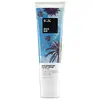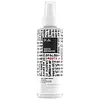What's inside
What's inside
 Key Ingredients
Key Ingredients

No key ingredients
 Benefits
Benefits

 Concerns
Concerns

 Ingredients Side-by-side
Ingredients Side-by-side

Water
Skin ConditioningButylene Glycol
HumectantAcrylates/Beheneth-25 Methacrylate Copolymer
Cocos Nucifera Oil
MaskingDimethicone PEG-8 Meadowfoamate
EmollientMica
Cosmetic ColorantAloe Barbadensis Flower Extract
EmollientChamomilla Recutita Flower Extract
MaskingRosa Canina Fruit Extract
AstringentCymbopogon Schoenanthus Extract
Skin ConditioningAchillea Millefolium Extract
CleansingSymphytum Officinale Callus Culture Extract
Skin ConditioningGeranium Maculatum Extract
TonicHamamelis Virginiana Bark/Leaf/Twig Extract
Skin ConditioningMelissa Officinalis Leaf Extract
Skin ConditioningSalvia Officinalis Leaf Extract
CleansingQuercus Alba Bark Extract
AstringentPEG-40 Hydrogenated Castor Oil
EmulsifyingTrimethylsiloxyamodimethicone
C11-15 Pareth-7
EmulsifyingC12-16 Pareth-9
EmulsifyingButyloctanol
HumectantSilicone Quaternium-16
Skin ConditioningUndeceth-11
EmollientUndeceth-5
EmulsifyingTrideceth-12
EmulsifyingPolyquaternium-59
UV AbsorberXanthan Gum
EmulsifyingGlycerin
HumectantEthylhexylglycerin
Skin ConditioningAminomethyl Propanol
BufferingCarbomer
Emulsion StabilisingPhenoxyethanol
PreservativeParfum
MaskingBenzyl Salicylate
PerfumingCoumarin
PerfumingGeraniol
PerfumingLimonene
PerfumingLinalool
PerfumingCI 77891
Cosmetic ColorantWater, Butylene Glycol, Acrylates/Beheneth-25 Methacrylate Copolymer, Cocos Nucifera Oil, Dimethicone PEG-8 Meadowfoamate, Mica, Aloe Barbadensis Flower Extract, Chamomilla Recutita Flower Extract, Rosa Canina Fruit Extract, Cymbopogon Schoenanthus Extract, Achillea Millefolium Extract, Symphytum Officinale Callus Culture Extract, Geranium Maculatum Extract, Hamamelis Virginiana Bark/Leaf/Twig Extract, Melissa Officinalis Leaf Extract, Salvia Officinalis Leaf Extract, Quercus Alba Bark Extract, PEG-40 Hydrogenated Castor Oil, Trimethylsiloxyamodimethicone, C11-15 Pareth-7, C12-16 Pareth-9, Butyloctanol, Silicone Quaternium-16, Undeceth-11, Undeceth-5, Trideceth-12, Polyquaternium-59, Xanthan Gum, Glycerin, Ethylhexylglycerin, Aminomethyl Propanol, Carbomer, Phenoxyethanol, Parfum, Benzyl Salicylate, Coumarin, Geraniol, Limonene, Linalool, CI 77891
Water
Skin ConditioningCetearyl Alcohol
EmollientSilicone Quaternium-8
Spirulina Maxima Extract
SmoothingCocos Nucifera Oil
MaskingGlycerin
HumectantPanthenol
Skin ConditioningRosa Canina Seed Oil
EmollientSalvia Hispanica Seed Oil
MoisturisingHelianthus Annuus Seed Extract
Skin ConditioningRosa Centifolia Flower Water
Skin ConditioningSambucus Nigra Flower Water
Skin ConditioningGlycolic Acid
BufferingBehentrimonium Methosulfate
PEG-12 Dimethicone
Skin ConditioningTrideceth-10
CleansingPotassium Sorbate
PreservativePolyquaternium-59
UV AbsorberCetrimonium Chloride
AntimicrobialButylene Glycol
HumectantSodium PCA
HumectantSodium Lactate
BufferingArginine
MaskingAspartic Acid
MaskingCystine Bis-Pg-Propyl Silanetriol
Skin ConditioningPCA
HumectantGlycine
BufferingAlanine
MaskingSerine
MaskingValine
MaskingIsoleucine
Skin ConditioningProline
Skin ConditioningThreonine
Citric Acid
BufferingHistidine
HumectantPhenylalanine
MaskingSodium Benzoate
MaskingParfum
MaskingPhenoxyethanol
PreservativeEthylhexylglycerin
Skin ConditioningWater, Cetearyl Alcohol, Silicone Quaternium-8, Spirulina Maxima Extract, Cocos Nucifera Oil, Glycerin, Panthenol, Rosa Canina Seed Oil, Salvia Hispanica Seed Oil, Helianthus Annuus Seed Extract, Rosa Centifolia Flower Water, Sambucus Nigra Flower Water, Glycolic Acid, Behentrimonium Methosulfate, PEG-12 Dimethicone, Trideceth-10, Potassium Sorbate, Polyquaternium-59, Cetrimonium Chloride, Butylene Glycol, Sodium PCA, Sodium Lactate, Arginine, Aspartic Acid, Cystine Bis-Pg-Propyl Silanetriol, PCA, Glycine, Alanine, Serine, Valine, Isoleucine, Proline, Threonine, Citric Acid, Histidine, Phenylalanine, Sodium Benzoate, Parfum, Phenoxyethanol, Ethylhexylglycerin
Ingredients Explained
These ingredients are found in both products.
Ingredients higher up in an ingredient list are typically present in a larger amount.
Butylene Glycol (or BG) is used within cosmetic products for a few different reasons:
Overall, Butylene Glycol is a safe and well-rounded ingredient that works well with other ingredients.
Though this ingredient works well with most skin types, some people with sensitive skin may experience a reaction such as allergic rashes, closed comedones, or itchiness.
Learn more about Butylene GlycolCocos Nucifera Oil is obtained from the kernels of the coconut fruit. In other words, this is coconut oil.
Coconut Oil is rich in fatty acids with lauric acid making up the majority of these. It also contains linoleic acid. Due to this high fatty acid content, coconut oil helps trap moisture and soften skin.
Despite being antibacterial, coconut oil may not be great for acne-prone skin. It is comedogenic and may clog pores. This ingredient may not be safe for malassezia or fungal acne.
Note: Coconut Oil should not replace your sunscreen for UV protection. Studies show it only blocks about 20% of UV.
This oil is non-volatile and has a light scent.
The term 'fragrance' is not regulated in many countries. In many cases, it is up to the brand to define this term. For instance, many brands choose to label themselves as "fragrance-free" because they are not using synthetic fragrances. However, their products may still contain ingredients such as essential oils that are considered a fragrance.
Learn more about Cocos Nucifera OilEthylhexylglycerin (we can't pronounce this either) is commonly used as a preservative and skin softener. It is derived from glyceryl.
You might see Ethylhexylglycerin often paired with other preservatives such as phenoxyethanol. Ethylhexylglycerin has been found to increase the effectiveness of these other preservatives.
Glycerin is already naturally found in your skin. It helps moisturize and protect your skin.
A study from 2016 found glycerin to be more effective as a humectant than AHAs and hyaluronic acid.
As a humectant, it helps the skin stay hydrated by pulling moisture to your skin. The low molecular weight of glycerin allows it to pull moisture into the deeper layers of your skin.
Hydrated skin improves your skin barrier; Your skin barrier helps protect against irritants and bacteria.
Glycerin has also been found to have antimicrobial and antiviral properties. Due to these properties, glycerin is often used in wound and burn treatments.
In cosmetics, glycerin is usually derived from plants such as soybean or palm. However, it can also be sourced from animals, such as tallow or animal fat.
This ingredient is organic, colorless, odorless, and non-toxic.
Glycerin is the name for this ingredient in American English. British English uses Glycerol/Glycerine.
Learn more about GlycerinParfum is a catch-all term for an ingredient or more that is used to give a scent to products.
Also called "fragrance", this ingredient can be a blend of hundreds of chemicals or plant oils. This means every product with "fragrance" or "parfum" in the ingredients list is a different mixture.
For instance, Habanolide is a proprietary trade name for a specific aroma chemical. When used as a fragrance ingredient in cosmetics, most aroma chemicals fall under the broad labeling category of “FRAGRANCE” or “PARFUM” according to EU and US regulations.
The term 'parfum' or 'fragrance' is not regulated in many countries. In many cases, it is up to the brand to define this term.
For instance, many brands choose to label themselves as "fragrance-free" because they are not using synthetic fragrances. However, their products may still contain ingredients such as essential oils that are considered a fragrance by INCI standards.
One example is Calendula flower extract. Calendula is an essential oil that still imparts a scent or 'fragrance'.
Depending on the blend, the ingredients in the mixture can cause allergies and sensitivities on the skin. Some ingredients that are known EU allergens include linalool and citronellol.
Parfum can also be used to mask or cover an unpleasant scent.
The bottom line is: not all fragrances/parfum/ingredients are created equally. If you are worried about fragrances, we recommend taking a closer look at an ingredient. And of course, we always recommend speaking with a professional.
Learn more about ParfumPhenoxyethanol is a preservative that has germicide, antimicrobial, and aromatic properties. Studies show that phenoxyethanol can prevent microbial growth. By itself, it has a scent that is similar to that of a rose.
It's often used in formulations along with Caprylyl Glycol to preserve the shelf life of products.
We don't have a description for Polyquaternium-59 yet.
Water. It's the most common cosmetic ingredient of all. You'll usually see it at the top of ingredient lists, meaning that it makes up the largest part of the product.
So why is it so popular? Water most often acts as a solvent - this means that it helps dissolve other ingredients into the formulation.
You'll also recognize water as that liquid we all need to stay alive. If you see this, drink a glass of water. Stay hydrated!
Learn more about Water